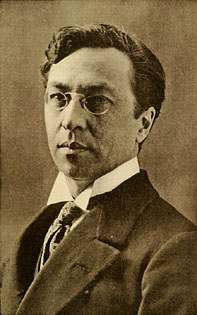Voir l'invisible, Michel Henry, 1988
Vassily Kandinsky citations célèbres
Voir l'invisible, , 1988
Cette base sera définie comme le principe de la nécessité intérieure.
Du spirituel dans l’art, 1911
Voir l'invisible, , 1988
Point et ligne sur plan, 1926
Du spirituel dans l’art, 1911
Citations de l'âme de Vassily Kandinsky
Du spirituel dans l’art, 1911
Du spirituel dans l’art, 1911
Regards sur le passé, 1912-1922
Vassily Kandinsky: Citations en anglais
Quote from: 'Analysis of the Primary Elements of Painting', W. Kandinsky, 1928
1920 - 1930
Source: 1916 -1920, Autobiography', 1918, p. 34
Kandinsky is remembering his experience that he saw one of the 'Haystack' paintings of Monet, for the first time in his life, in Moscow (1895)
Source: 1916 -1920, Autobiography', 1918, p. 10
Quote of Kandinsky, 1911; in Concerning the Spiritual in Art, transl. Michael T. Sadler (1914); reprint. New York: Dover, 1977), p. 17
1910 - 1915
Quote from Concerning the Spiritual in Art, Wassily Kandinsky, Munich, 1912; as cited in Kandinsky, Frank Whitford, Paul Hamlyn Ltd, London 1967, p. 15
1910 - 1915
Source: 1916 -1920, Autobiography', 1918, p. 33
1910 - 1915, On the Problem of Form (1912)
Source: 1916 -1920, Autobiography', 1918, p. 9
Quote of Kandinsky, from Bauhaus - Zeitschrift für Gestaltung, no. 3, 1931; as cited in 'Klee & Kandinsky', 2015 exhibition text, Lenbachhaus und Kunstbau Munich, 2015-2016 https://www.zpk.org/en/exhibitions/review_0/2015/klee-kandinsky-969.html
1930 - 1944
as quoted in Wassily Kandinsky: Life and Work, Will Grohmann. H. N. Abrams, 1958 p. 78
1920 - 1930
Quote, c. 1910; as cited by de:Wolf-Dieter Dube, in Expressionism; Praeger Publishers, New York, 1973, p. 112
1910 - 1915
Source: 1916 -1920, Autobiography', 1918, p. 9
“Opposites and contradictions, that is our harmony.”
German original: Gegensätze und Widerspruche, dass ist unsere Harmonie.
short quote, 1911; as cited in schönberg and Kandinsky: An Historic Encounter, by Klaus Kropfinger; ed. Konrad Boehmer; published by Routledge (imprint of Taylor & Francis, an informal company), 2003, p. 9, note 1
1910 - 1915
in his letter to Arnold Schönberg, 18 Jan. 1911; as cited in Schonberg and Kandinsky: An Historic Encounter, by Klaus Kropfinger; edited by Konrad Boehmer; published by Routledge (imprint of Taylor & Francis, an informal company), 2003, p. 9
Kandinsky visited a concert with music of Schönberg on 11 Jan. 1911 with Franz Marc, Alexej von Jawlensky, Gabriele Münter and others; they played compositions, Schönberg wrote in 1907 and 1909: his second string quartet and the 'Three piano pieces'
1910 - 1915
Quote from: On the Spiritual in Art, 1911; as cited in Schönberg and Kandinsky: An Historic Encounter, by Klaus Kropfinger; edited by Konrad Boehmer; published by Routledge (imprint of Taylor & Francis, an informal company), 2003, p. 17
1910 - 1915
1920 - 1930, Point and line to plane, 1926
Quote of Kandinsky, in Paris, March 1935; as cited in Artists on Art – from the 14th – 20th centuries, ed. by Robert Goldwater and Marco Treves; Pantheon Books, 1972, London, p. 451
1930 - 1944
Source: 1916 -1920, Autobiography', 1918, p. 16
I. Kandinsky's introduction: Lead paragraph
1910 - 1915, Concerning the Spiritual in Art, 1911
“[Art is].. the mysterious expression of the mysterious..”
Source: 1916 -1920, Autobiography', 1918, p. 17
of Die Brücke paintings in The Blaue Reiter Almanac
Quote from his letter to Franz Marc, 2 Febr. 1912, as cited in 'Lankheit 20'; quoted in Movement, Manifesto, Melee: The Modernist Group, 1910-1914, Milton A. Cohen, Lexington Books, Sep 14, 2004, p. 71
1910 - 1915
'..stripes and spots with the knife', as he learned then also Gabriele Münter - they frequently painted together in open air
Source: 1916 -1920, Autobiography', 1918, p. 31
Quote from Kandinsky's letter to Gabriele Münter, June 1916; as cited in lrike Becks-Malorny, Wassily Kandinsky, 1866–1944: The Journey to Abstraction [Cologne: Taschen, 1999], pp. 115, 118
Kandinsky left Münter and Murnau in 1914, because the first World War started and Kandinsky had a Russian nationality
1916 -1920
Quote of Kandinsky, Munich, 1910; as cited in Artists on Art – from the 14th – 20th centuries, ed. by Robert Goldwater and Marco Treves; Pantheon Books, 1972, London, p. 450
1910 - 1915
Quote of Kandinsky, in the introduction of an exhibition-catalog 'Neue Künstlervereinigung', 1913, Munich; as cited by , in Expressionism; Praeger Publishers, New York, 1973, p. 119-120
1910 - 1915
“An empty canvas is a living wonder - far lovelier than certain pictures.”
Quoted in: Myfanwy Evans Piper (1937) The Painter's Object. p. 53
1930 - 1944
as quoted by de:Wolf-Dieter Dube, in Expressionism; Praeger Publishers, New York, 1973, p. 109
undated quotes
Quote of Kandinsky, from the catalog of the second exhibition of the 'Neue Künstlervereinigung', München, August, 1910; as cited by de:Wolf-Dieter Dube, in Expressionism; Praeger Publishers, New York, 1973, p. 95
1910 - 1915
From an interview, 28 July 1935, in the Italian daily newspaper 'Lavoro fascista'; as quoted in Kandinsky in Paris: 1934-1944 - exhibition catalog, published by The Solomon K. Guggenheim Foundation, New York, 1985, p. 30
1930 - 1944
